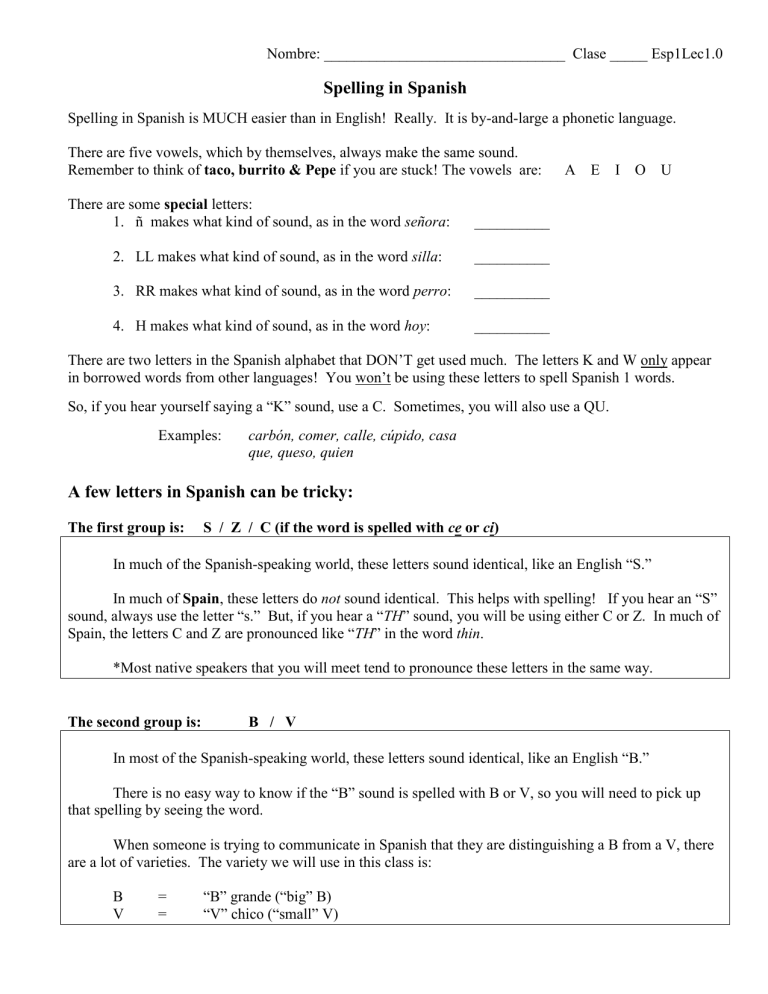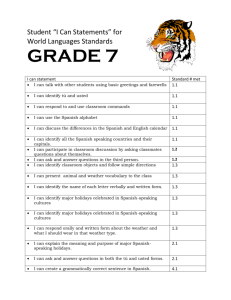Spelling in Spanish A few letters in Spanish can be tricky:

Nombre: ________________________________ Clase _____ Esp1Lec1.0
Spelling in Spanish
Spelling in Spanish is MUCH easier than in English! Really. It is by-and-large a phonetic language.
There are five vowels, which by themselves, always make the same sound.
Remember to think of taco, burrito & Pepe if you are stuck! The vowels are: A E I O U
There are some special letters:
1.
ñ makes what kind of sound, as in the word señora : __________
2.
LL makes what kind of sound, as in the word silla : __________
3.
RR makes what kind of sound, as in the word perro : __________
4.
H makes what kind of sound, as in the word hoy : __________
There are two letters in the Spanish alphabet that DON’T get used much. The letters K and W only appear in borrowed words from other languages! You won’t be using these letters to spell Spanish 1 words.
So, if you hear yourself saying a “K” sound, use a C. Sometimes, you will also use a QU.
Examples: carbón, comer, calle, cúpido, casa que, queso, quien
A few letters in Spanish can be tricky:
The first group is: S / Z / C (if the word is spelled with ce or ci )
In much of the Spanish-speaking world, these letters sound identical, like an English “S.”
In much of Spain , these letters do not sound identical. This helps with spelling! If you hear an “S” sound, always use the letter “s.” But, if you hear a “ TH ” sound, you will be using either C or Z. In much of
Spain, the letters C and Z are pronounced like “ TH
” in the word thin .
*Most native speakers that you will meet tend to pronounce these letters in the same way.
The second group is: B / V
In most of the Spanish-speaking world, these letters sound identical, like an English “B.”
There is no easy way to know if the “B” sound is spelled with B or V, so you will need to pick up that spelling by seeing the word.
When someone is trying to communicate in Spanish that they are distinguishing a B from a V, there are a lot of varieties. The variety we will use in this class is:
B
V
=
=
“B” grande (“big” B)
“V” chico (“small” V)
The third group is:
The fourth group is:
Y / LL
In most of the Spanish-speaking world, these letters sound identical, like an English “Y.”
There is no easy way to know if the “Y” sound is spelled with Y or LL, so you will need to pick up that spelling by seeing the word.
Examples: ella, silla, llamo and yo
J / G (if the word is spelled with ge or gi )
The letters J and G (if the word is spelled ge or gi
) are both pronounced with an “H” sound.
Remember, the letter H is silent in Spanish.
There is no guaranteed way to know whether you should use a J or G, when the sound is “ HE” or
“HI ,” but my advice is that there are MANY more words spelled with ge or gi, than there are je or ji .
Examples: gente, gimnasio, joven, jueves
Accent marks in Spanish:
Spanish has “accent marks.”
Accent marks are never optional . They are part of correct spelling. Accent marks show you where to stress the word if you are reading it. If you have a great visual memory, you will probably have an easier time of remembering which words need accents.
The easiest way to learn to correctly use accent marks is to see them used in context many, many times.
Your brain will begin to pick up on patterns, such as “ Hmmm…every time a word ends in –ion, it’s always spelled –ión.
”
There are official rules to using accent marks, which we will learn as the year progresses. But for now, trust your brain to do what it is capable of--- noticing patterns.





